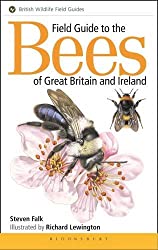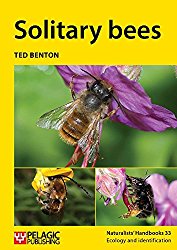Field
Guide to the Bees of Great Britain and Ireland by Steven Falk
Illustrated
by Richard Lewington
At last, a book which details each of the 275 British and
Irish bee species! This is a superb book, and a wonderful achievement!
Book Review
The book provides all the general background you would expect from a book of this type, including habitat, classification, life cycle and conservation.
There is also a very useful ‘at a glance’ guide to bee genera and genus very early in the book, and a very useful glossary and key. We then get into the detail:
- The identification part is split into sections -
as you’d expect, by genera. Within each
section, there is a general description of each genus, an illustration by
Lewington, and images of associated species and parasites. Each species is then described in detail,
with photographs, habitat, flight season etc.

- As well as the scientific name for each species,
Falk also provides the common name.
I especially appreciate this: having given a number of talks about bees, I know it is far more memorable and – yes, even amusing, to talk about the Hairy Footed Flower Bee rather than Anthophora plumipes, for example.
Where many people have grown up thinking about bees in terms of stings, who can fail to be won over by the mere thought of the Pantaloon Bee, the Patchwork Leafcutter Bee (or Wood-carving Leafcutter, for that matter)?
- The book also features 20 superb colour plates.
- For me, a major strength of this brilliant book is that at
last, we have a truly comprehensive guide which includes all the solitary
species.
Readers will soon find there is so much to learn about these important pollinators – to be fair, they receive little attention, and may even be wrongly mistaken for flies (or even wasps). It’s only by first acknowledging, then learning about the different solitary species, that we can take positive action to help them where we can, by providing habitat and foraging opportunities where possible, and lobbying to protect sites of specific importance. For this to be the case, awareness needs to spread more widely.
In terms of the tone of the book, I would describe is as being most appropriate for a student of ecology or entomology, or for seriously interested general enthusiasts who are prepared to wade through the scientific terms used to describe parts of the anatomy.
I also, in general, advise against pinning (killing) bees for the purpose of amateur study, and advocate against unnecessary killing even in the name of scientific study - after all, surely there are many collections, photographs etc available already? I am also alarmed at 'Citizen Science' projects that encourage members of the public to trap bees and kill them for a display board.
The Author And Illustrator
Steven Falk is an entomologist, invertebrate specialist and wildlife
artist. He is also the author of British
Hoverflies, and Warwickshire’s
Wildflowers.
He worked as an entomologist with
the Nature Conservancy Council, as Keeper of Natural History and then City
Ecologist at Coventry Museum, and spent 11 years as Senior Keeper of Natural
History at Warwickshire Museum. He worked for Buglife - the Invertebrate
Conservation Trust as their Entomologist and Invertebrate Specialist from 2012
until 2015.
In 2012 Steven was awarded the prestigious Royal Entomological Society/Marsh
Award for Insect Conservation.
Richard Lewington is a celebrated wildlife artist, and you
can admire some of his beautiful bee-themed art which previously featured on
British postage stamps.
This book was originally on my Christmas list – I wanted the hard back version, but having taken yet more photographs this year, I decided I couldn’t wait any longer, and so I treated myself (to the paperback version). I’m glad I did! I find it an invaluable book that I has already helped me to identify quite a lot of bee species
So would I recommend this book? Definitely!
Field Guide to Bees Of Great Britain And Ireland - by Steven Falk is available from Amazon and other good book shops.
BuzzAboutBees.net is a member of the Amazon Associates Program.
As an Amazon Associate I earn from qualifying purchases if you click on a link from my website to an Amazon website page. I only recommend books and goods I myself like. Further information, see: Advertising And Affiliates Disclosure.
If you found this page helpful or interesting, I'd really be grateful if you would share it with others - if not this page, perhaps another, such as Gardening For Bees.
Thank you so much :) .
